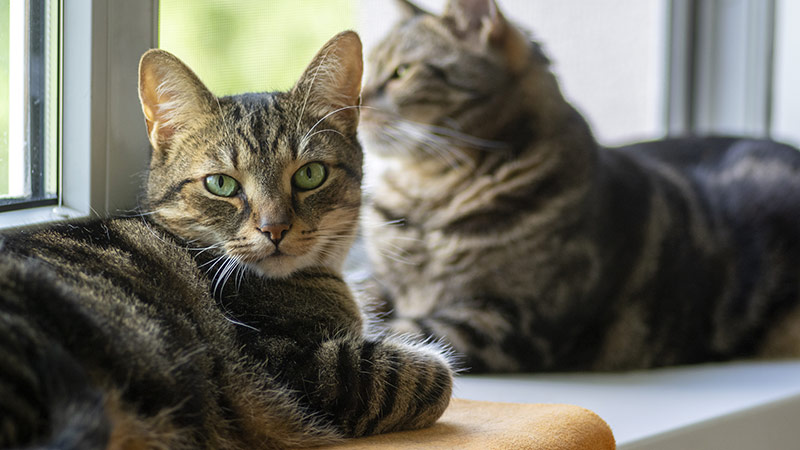
Cats have evolved as solitary hunters and are very comfortable with their own company. The decision to bring new cats home should be made with the understanding that it can be stressful for the resident cat. The nice thing to know is cats do not have a dominant social structure and can develop friendly relationships with each other over time. They will require adequate space and resources and support from the rest of their pet family to ensure successful integration.
Cats are okay subletting their space – most of the time
Cats can learn to timeshare resources given we keep these factors in mind:- Siblings make good friends.
- Cats of opposite gender may develop easier relationships.
- Kittens are more easily introduced than older cats.
- Hiding boxes and vertical resting places give cats their own private space where they can see who’s coming toward them.
- One litter box per cat – plus one is a good rule. The boxes should be in different rooms for best effect. Three litter boxes in the laundry room equals one big litter box.
- Food and water in shallow bowls allow your cat to see who else might be interested in their breakfast.
Steps for kitty introductions
- Take it slowly. Lots of cats prefer their own company or the presence of direct family members. Successful introductions may take weeks to months, especially for older cats.
- Separate the cats for as long as it takes. Start by keeping the new cat in their own room, with feeding dishes and a litter box, to get used to the smells, noises, and pace of your home. This stage also allows us to ensure that there are no health concerns like sneezing, runny eyes, and diarrhea.
- Switch. Allow the new cat to roam the main part of your home while resident kitty gets to spend time in new kitty’s special room. Swap food bowls and bedding to introduce the scent of the other cat in positive ways.
- Consider Feliway® - to mimic kitty pheromones. Happy pheromones tell animals of the same species that everything is okay. Spritz pheromones on bedding, furniture, wall corners, and in litter boxes to relieve anxiety for both cats. Encourage natural pheromone exchange by allowing cats to rub their foreheads against these same surfaces. Be cautious with relaxing essential oils, because these can be toxic to cats.
- Allow them to see each other. Cats should meet across a room from each other; you can also use a baby gate or screen door to keep them physically separated. Keep first intros short and positive. If they are calm and curious, they can be allowed to move more closely. Offer food kibble, special treats, and toys to reward positive body language and behaviours. The slow blink with forward-facing ears represents a kitty smile. Always watch for flattening of ears and slow twitching of the tail as signs that a cat is stressed and needs to leave the situation.
- Gradually increase their time together and allow face-to-face meetings. It’s okay if they hiss a little as long as they move away from each other. If one cat is hissing and stalks or charges the other cat, clap your hands or shout to surprise them. We may need to repeat distance introductions for a few more days or weeks.
- Never separate fighting cats with your hands. Anxious cats can re-direct their fear and aggression toward you, which may result in serious bites and scratches. If the cats start to fight, use a large pillow or soft broom to sweep (literally!) one of the cats away. They tend to grab whatever is moving, and you can often carry the pillow or broom, cat attached, out of the room.
- Place a bell collar on any assertive cats. Young cats and pushy cats may be more likely to force their attentions on an older or anxious cat. A jingling bell lets them know where the assertive cat is and allows them the choice of staying put or moving out of the way.
Patience is the key.
Your cats will have a lifetime to spend together, so start their relationship as best you can. Monitor cat behaviours to figure out who likes which resting spots, litter boxes, and feeding places and be prepared to adjust as necessary. Many short visits may be required until the cats are relaxed around each other. ittens and young cats are more likely to become friends in less time. Remember, they may never be best friends, and that is perfectly fine.
Pet insurance can help with the cost of vet visits
Contact your veterinarian if you see excessive fighting, peeing outside the litter box, or decreased appetite and hiding. Learn what’s covered by Petsecure and get a free quote today.
